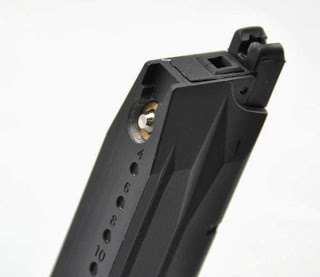 This is a really common question from just about every airsofter out there. What is the best way to maintain my GBB magazines?
This is a really common question from just about every airsofter out there. What is the best way to maintain my GBB magazines?
#1 is to mind what you feed it. The best method is to use green gas
that already has a silicone lube mixture inside it. The more popular
alternative is a propane bottle with a fill adapter because this is much
cheaper. Care must be taken with this
latter step, however. It is highly advisable that you apply several
drops of fine silicone lube to the top of the propane bottle before
screwing on the adapter. I recommend doing this for at least every 3rd
magazine fill.
The number one killer of GBB magazines is worn,
cracked, or dried out o-rings. An o-ring leak will obviously bleed off
whatever gas you have stored in the fill chamber slowly, or quickly,
depending on how bad your leak is. The best measures are preventative
measures. Keep your o-rings hydrated and they will last a long time. Raw
propane gas has a tendency to dry things out. This can be exacerbated
by temperature extremes too. Freezing, or shooting extremely fast (if
your gas allows it) in cold temperatures can adversely affect the
performance of the o-rings.
There are lubes out there designed
to “breathe new life into” dry o-rings. They are usually marketed under
the name of “Gas Blowback Magazine Saver” or the like. I have used
these with good success – most of them do work well. Generally you
depress the valve on the back of the magazine, place a few drops of the
lube into the top of the gas chamber opening, and then fill your
magazine with gas. Typically you leave the mag sitting upright for a
period of time up to 24 hours or so. I prefer to vent the contents of
the magazine afterwards, rather than fire it through the weapon as the
lube can tend to find its way down your barrel otherwise.
#2,
after o-rings, valves are the weakest link in the GBB magazine. These
are usually made of brass, plated brass, or in some cases, aluminum, or
steel. 90% of the time, they will be brass due to brass having good
self-lubricity properties. Potential for brass to be damaged, especially
when screwing it into harder metals, such as aluminum or steel are
there. It can be easy to damage the threads or chew out the slot for
your screwdriver, or even bend valve if you monkey too hard with it. The
valve usually contains two or more o-rings depending on design. These
o-rings are usually the ones that die over time. Finding and replacing
these o-rings can be a real pain, to impossible in some cases. 90% of
the time, you’re simply better off saving yourself the time, grief, and
agony by just biting the bullet and replacing the valve altogether.
Additionally, some valves are rather complicated affairs of engineering,
and don’t lend themselves easily to being dissembled without completely
compromising the structure to the point of making it impossible to
reassemble. If your valve is bad, try to rehydrate the o-ring first. If
this doesn’t work, take it apart, replace what o-rings you can access or
can determine to be bad. If that still doesn’t work, replace the valve.
Valves can be expensive, so once again, preventative maintenance is the
key here to ensuring long life.
I have read of some folks
using automotive gasket sealer to seal the valve to the magazine body. I
really don’t recommend this because it can be near impossible to remove
a bad valve due to this stuff. Remember: most valves are brass. It
doesn’t take much effort or a bad slip to chew up the slot and
completely trash your ability to remove a valve.
Another
common issue with valves is the valve plunger fails to depress
consistently or drags. This is usually the result of gunk, debris, or
bad manufacturing process (a machining burr) preventing it from working
properly. Blow it out if you can. If it doesn’t work after this, then it
is likely a defect and should be replaced. Plungers are another item
that is difficult and time consuming to fix.
#3 is relatively
simple. On GBB pistol mags, it pays to keep your feedway for your BB’s
clean. Lube and debris tends to collect in this channel during firing.
If you observe closely, it is not uncommon for this to severely
contaminate the cleanliness of your BB’s. This translates itself
directly to your barrel, which translates to decreased accuracy. The
feeble pipe cleaner is your friend here. Lock your spring back, double
up the pipe cleaner in half, and clean that channel out. Your BB’s will
thank you and your barrel will thank you.
#4, I have never
personally seen or heard of a case where the gas chamber of a magazine
was cracked or compromised in such a fashion as it leaked like a sieve.
Typically these are milled or case from a solid block of steel or
aluminum. It would be very hard to destroy one. Your o-rings and valves
will go out first before you ever destroy the main gas chamber.